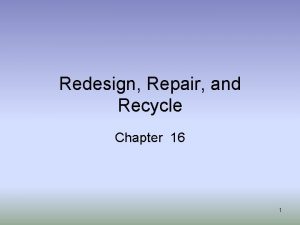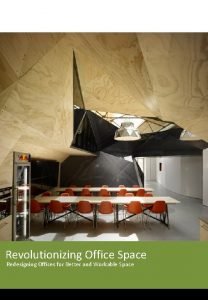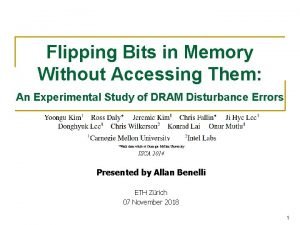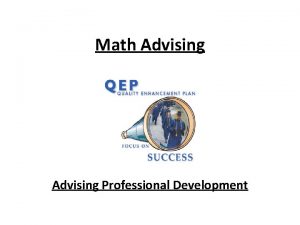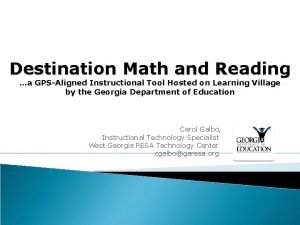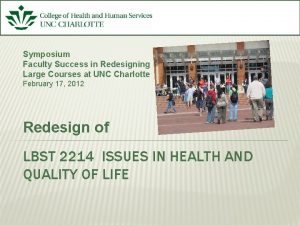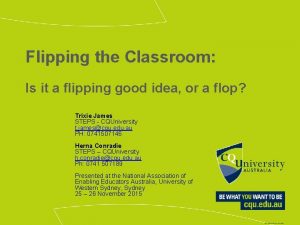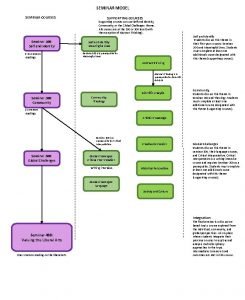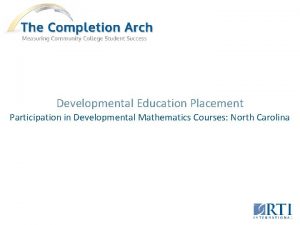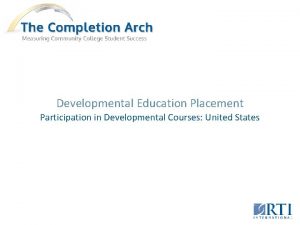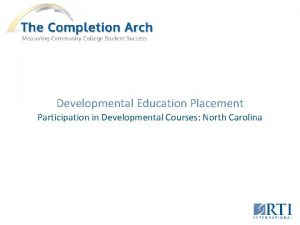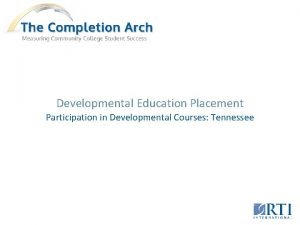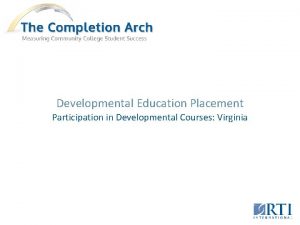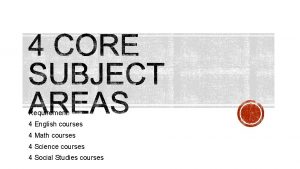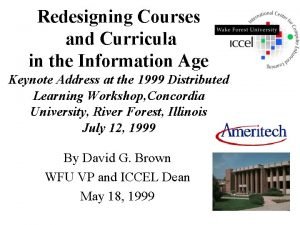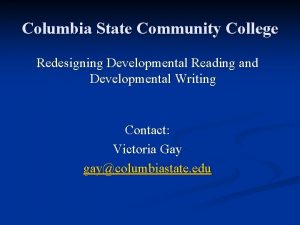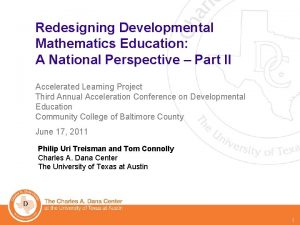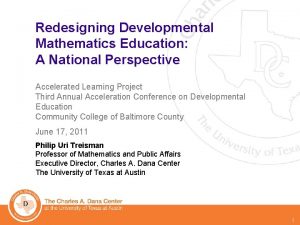Flipping Math Redesigning Developmental Math Courses for Success
























- Slides: 24

Flipping Math: Redesigning Developmental Math Courses for Success Broward College Presenters: Kelli Hammer, Professor and Developmental Ed. Coordinator of Mathematics Alan Lebovitz, Associate Dean of Mathematics – North Campus Joyce Nemeth, Associate Dean of Mathematics – South Campus

Workshop Overview § Broward College - who we are § Why Math Redesign/flipped model? § Evolution and implementation of our flipped model § Specifics of BC’s flipped model – Facilitation, Standardization, Assessment § Evidence of success

Broward College § Third largest of 28 colleges in the Florida College System § Three major campus with six centers throughout the county § Over 67, 000 students enrolled annually § Diverse student body § Certificates, associate degrees and select bachelor’s degrees § #3 in nation in associate degrees awarded to minority students § In the past, ~65% begin in developmental education (more than half in math). Starting in January 2014, changes in state law allow the majority of students to bypass developmental courses.

Why Math Redesign? § Math is the #1 obstacle for students. Students beginning in lowest level are seven times less likely to graduate than students who begin in college-level math § Path includes three math classes before a college level math course: Development Math I (Pre-Algebra), Developmental Math II (Elementary Algebra), Intermediate Algebra § In 2008, mathematics faculty and Associate Deans met to discuss how to redesign our developmental math classes to enhance student success § Main inspiration came from Beyond Crossroads, which emphasized the idea of “flipping the classroom” § Change classes from instructor-based lecture to classes in which the students are actively engaged in the learning process with peer learning

Why Math Redesign? § Faculty attended conferences and visited other colleges to learn about various redesign and/or emporium models of instruction and concluded: o students learn by doing o students work better collaboratively o attention spans aren’t what they used to be § Used what they learned and the flipped classroom idea to adopt new model with: o video mini lectures o in-class, collaborative assignments in the form of worksheets o homework assignments to be completed online

Why Math Redesign? § This model was adopted for the three courses in the pre-general education math pathway and college algebra § Goal of acceleration was added § Classes were designed to meet four days a week during two 8 -week sessions (Sessions 2 and 4) as opposed to the traditional two days a week classes during a 16 -week semester § This allowed students to complete two courses in a single semester

Evolution of Math Redesign § Initial pilot phase was from Fall 2009 through Winter 2012 (six major semesters) § First year included software trials before agreeing on ALEKS. § Faculty piloted various homework management systems (HMS) § Each campus and instructor used at least two different systems over a 1 -year pilot § ALEKS was selected unanimously as the permanent HMS. § During the second and third years, faculty developed standardized course shells (formerly Blackboard, currently Desire 2 Learn) containing common: § Syllabi § Classwork § Course pacing § Tests § Video lecture sources § Grading system/point distribution § Lecture/class notes § ALEKS content

Evolution of Math Redesign § Program was scaled up starting in Fall 2012 with a 151% increase in course offerings from the previous Fall semester (35 to 88). The total number of sections for the current Fall semester is 126. § During the scale-up period, faculty continued to update course shells and meet on a regular basis to discuss and implement improvements § Faculty are now encouraged to personalize the daily lecture, worksheets and/or tests to “make the class their own”

Implementation and Logistics § Initially, the only faculty who taught flipped redesign classes were the ones who were involved in its development § In subsequent semesters, additional faculty were recruited by the Associate Deans on all campuses to participate, starting with a mentor/mentee program § These faculty observed multiple flipped redesign classes to witness first-hand the implementation of the program § Expanded by having the Associate Deans personally invite faculty to teach flipped redesign classes

Implementation and Logistics § Multiple training sessions on all campuses assisted faculty with the transition into this modality, including the use of ALEKS, course shells and proper classroom implementation § Informal observations conducted by Associate Deans and faculty mentors to assure that the model was being followed correctly § Meetings with Associate Deans and faculty mentors to address faculty concerns and correct deviations from the model

Implementation and Logistics § Originally, faculty were scheduled to teach the same course in both sessions to make it easier for faculty to adjust to the new modality § Changed to scheduling sequential courses in consecutive sessions to allow students who passed the first course to move seamlessly into the second course § Registration in the second course of a two course cohort is restricted so all students enrolled in the first course can register for the second § Most meet four days a week but some are now scheduled for two days a week to meet students’ and faculty needs § Additional standalone classes were added as needed

Implementation and Logistics Sample Scheduling Course Session Instructor Start Time End Time Days Pre-Algebra Elem. Algebra 2 4 Hammer 12: 30 PM 1: 45 PM MTWR Elem. Algebra Interm. Algebra 2 4 Lucke 11: 00 AM 12: 15 PM MTWR Interm. Algebra College Algebra 2 4 Castillo 2: 00 PM 3: 15 PM MTWR Elem. Algebra Interm. Algebra 2 4 Macfarlane 6: 30 PM 9: 15 PM MW MW College Algebra 2 Amato 9: 30 AM 10: 45 AM MTWR Elem. Algebra 4 Mancini 9: 30 AM 10: 45 AM MTWR

BC’s “Flipped” Method - Facilitation § Instructors are facilitators of learning rather than traditional lecturers § Brief videos are shown or mini lectures are conducted § Students do a classwork assignment each day to reinforce the skill(s) just learned. Approximately 40% of class time is spent on worksheets § Students work collaboratively with their peers and receive assistance from the instructor § Students use technology to do their homework. This allows the faculty to monitor students’ progress and use intervention strategies.

BC’s “Flipped” Method - Standardization § Syllabus, course schedule and pacing, daily lessons, class work, grading system (samples in your handout) § This ensures all students, no matter the instructor, will receive the same quality and quantity of instruction § Curriculum of each course is consistent and matches our Broward College outlines to guarantee coverage of all of the Developmental Education Florida State Competencies




BC’s “Flipped” Method - Assessment § Class work is graded and returned to students at the next class meeting. Commonly missed questions are reviewed § ALEKS provides immediate feedback on each question and continuously reassesses students at various intervals § Students are assessed and graded using a variety of methods which helps the “poor test-taker” § The developmental and gateway courses have collegewide departmental cumulative final exams

BC’s “Flipped” Method - Bonuses § Students are more active learners § Readiness levels are verified in initial assessment in ALEKS § ALEKS is personalized, based on mastery, and has remediation built in § In ALEKS, students work towards goal completion and visualize their progress, not just “do homework” § Units in ALEKS are cumulative so students can run but not hide from a topic a/k/a “roll-over minutes” § Students are exposed to the necessary study habits to be successful in a math course § Textbook is not required, so students save money

Evidence: Are pass rates higher? ü Yes, significantly higher (p <<. 001)! Course Pass Rates (ABC) 2013 & 2014 Academic Years 70% 66% 60% 50% 62% 57% 50% 40% 66% 59% 50% 41% Traditional 30% 20% Flipped n=4989 n=1988 n=12023 n=3565 n=14399 n=2748 n=15350 n=1326 10% 0% Pre-Alg Beg. Alg. Int. Alg Col. Alg

Evidence: Are withdraw rates lower? ü Yes, significantly higher (p <. 005)! Course Withdraw Rates 2013 & 2014 Academic Years 16, 0% 12, 9% 12, 0% 10, 0% 15, 6% 15, 5% 14, 0% 10, 9% 9, 4% 8, 9% 8, 0% 10, 6% 9, 3% Traditional Flipped 6, 0% 4, 0% n=4989 n=1988 n=12023 n=3565 n=14399 n=2748 n=15350 n=1326 2, 0% 0, 0% Pre-Alg Beg. Alg. Int. Alg Col. Alg

Evidence: Are subsequent course pass rates higher? ü Yes, significantly higher (p <. 05), except for College Alg. Subsequent Course Pass Rates (ABC) within next two major terms 2013 Academic Year 70% 65% 60% 50% 40% 51% 67% 54% 50% 51% 43% Traditional 30% 20% 63% n=1781 n=605 n=2754 n=846 n=3471 n=874 n=4465 n=443 10% 0% Pre-Alg Beg. Alg. Int. Alg Col. Alg Flipped

Things we didn’t expect § Faculty are opting to use the flipped modality to teach 16 -week, semester long classes § Offering additional courses in two 8 -week cohorts § Students are requesting classes and instructors that use the flipped modality § Recent changes in Florida law require that all developmental courses be offered as accelerated, modularized, contextualized or have a college-level co-requisite. The law also allows ~75% of students to skip or ignore placement and take Intermediate Algebra § Math Redesign classes are now 100% of Pre-Algebra and Beginning Algebra sections § Use of ALEKS college-wide in Intermediate Algebra allows students with deficient skills to learn prerequisite material to be successful

Questions? Kelli Hammer – khammer@broward. edu Alan Lebovitz – alebovit@broward. edu Joyce Nemeth – jnemeth@broward. edu
 Redesigning old clothes
Redesigning old clothes Redesigning office space
Redesigning office space Redesigning the organization with information systems
Redesigning the organization with information systems Flipping bits in memory without accessing them
Flipping bits in memory without accessing them The probability of sandy flipping
The probability of sandy flipping Your child's success or lack of success
Your child's success or lack of success Your child's success or lack of success
Your child's success or lack of success Pcc moodle
Pcc moodle Destination math
Destination math Tack för att ni lyssnade
Tack för att ni lyssnade Tes debattartikel
Tes debattartikel Kung dog 1611
Kung dog 1611 Tobinskatten för och nackdelar
Tobinskatten för och nackdelar Vad är referatmarkeringar
Vad är referatmarkeringar Tack för att ni har lyssnat
Tack för att ni har lyssnat Vad är vanlig celldelning
Vad är vanlig celldelning Varför kallas perioden 1918-1939 för mellankrigstiden?
Varför kallas perioden 1918-1939 för mellankrigstiden? Programskede byggprocessen
Programskede byggprocessen Karttecken höjdkurva
Karttecken höjdkurva Lufttryck formel
Lufttryck formel Rbk-mätning
Rbk-mätning Densitet vatten
Densitet vatten Elektronik för barn
Elektronik för barn Tack för att ni har lyssnat
Tack för att ni har lyssnat Smärtskolan kunskap för livet
Smärtskolan kunskap för livet
